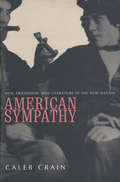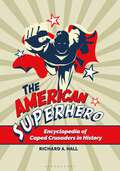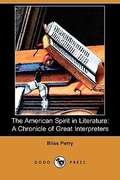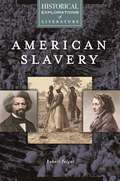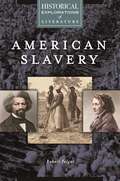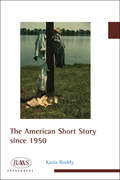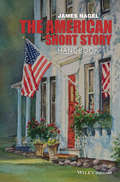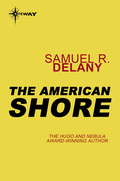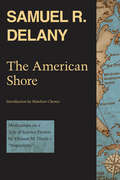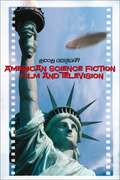- Table View
- List View
American Sympathy: Men, Friendship, and Literature in the New Nation
by Mr Caleb Crain"A friend in history,” Henry David Thoreau once wrote, "looks like some premature soul.” And in the history of friendship in early America, Caleb Crain sees the soul of the nation’s literature.In a sensitive analysis that weaves together literary criticism and historical narrative, Crain describes the strong friendships between men that supported and inspired some of America’s greatest writing--the Gothic novels of Charles Brockden Brown, the essays of Ralph Waldo Emerson, and the novels of Herman Melville. He traces the genealogy of these friendships through a series of stories. A dapper English spy inspires a Quaker boy to run away from home. Three Philadelphia gentlemen conduct a romance through diaries and letters in the 1780s. Flighty teenager Charles Brockden Brown metamorphoses into a horror novelist by treating his friends as his literary guinea pigs. Emerson exchanges glances with a Harvard classmate but sacrifices his crush on the altar of literature--a decision Margaret Fuller invites him to reconsider two decades later. Throughout this engaging book, Crain demonstrates the many ways in which the struggle to commit feelings to paper informed the shape and texture of American literature.
The American Superhero: Encyclopedia of Caped Crusaders in History
by Richard A. HallThis compilation of essential information on 100 superheroes from comic book issues, various print and online references, and scholarly analyses provides readers all of the relevant material on superheroes in one place.The American Superhero: Encyclopedia of Caped Crusaders in History covers the history of superheroes and superheroines in America from approximately 1938–2010 in an intentionally inclusive manner. The book features a chronology of important dates in superhero history, five thematic essays covering the overall history of superheroes, and 100 A–Z entries on various superheroes. Complementing the entries are sidebars of important figures or events and a glossary of terms in superhero research. Designed for anyone beginning to research superheroes and superheroines, The American Superhero contains a wide variety of facts, figures, and features about caped crusaders and shows their importance in American history. Further, it collects and verifies information that otherwise would require hours of looking through multiple books and websites to find.
The American Superhero: Encyclopedia of Caped Crusaders in History
by Richard A. HallThis compilation of essential information on 100 superheroes from comic book issues, various print and online references, and scholarly analyses provides readers all of the relevant material on superheroes in one place.The American Superhero: Encyclopedia of Caped Crusaders in History covers the history of superheroes and superheroines in America from approximately 1938–2010 in an intentionally inclusive manner. The book features a chronology of important dates in superhero history, five thematic essays covering the overall history of superheroes, and 100 A–Z entries on various superheroes. Complementing the entries are sidebars of important figures or events and a glossary of terms in superhero research. Designed for anyone beginning to research superheroes and superheroines, The American Superhero contains a wide variety of facts, figures, and features about caped crusaders and shows their importance in American history. Further, it collects and verifies information that otherwise would require hours of looking through multiple books and websites to find.
The American Spirit in Literature: A Chronicle of Great Interpreters
by Bliss PerryA unique set of short stories, poems and novels from the late 19th to early 20th centuries. From tales of love, life and heartbreaking loss to humorous stories of ghost encounters, these volumes captivate the imaginations of readers young and old. <P> <P> Included in this collection are a variety of dramatic and spirited poems that contemplate the mysteries of life and celebrate the wild beauty of nature. This is a history of American literature and writers that includes chapters on colonial literature, the knickerbockers, the transcendentalists, Emerson, Thoreau, Whitman, Poe and many others as well.
American Socialist Triptych: The Literary-Political Work of Charlotte Perkins Gilman, Upton Sinclair, and W. E. B. Du Bois (Class : Culture)
by Mark Van WienenAmerican Socialist Triptych: The Literary-Political Work of Charlotte Perkins Gilman, Upton Sinclair, and W. E. B. Du Bois explores the contributions of three writers to the development of American socialism over a fifty--year period and asserts the vitality of socialism in modern American literature and culture. Drawing upon a wide range of texts including archival sources, Mark W. Van Wienen demonstrates the influence of reform-oriented, democratic socialism both in the careers of these writers and in U.S. politics between 1890 and 1940. While offering unprecedented in-depth analysis of modern American socialist literature, this book charts the path by which the supposedly impossible, dangerous ideals of a cooperative commonwealth were realized, in part, by the New Deal. American Socialist Triptych provides in-depth, innovative readings of the featured writers and their engagement with socialist thought and action. Upton Sinclair represents the movement's most visible manifestation, the Socialist Party of America, founded in 1901; Charlotte Perkins Gilman reflects the socialist elements in both feminism and 1890s reform movements, and W. E. B. Du Bois illuminates social democratic aspirations within the NAACP. Van Wienen's book seeks to re-energize studies of Sinclair by treating him as a serious cultural figure whose career peaked not in the early success of The Jungle but in his nearly successful 1934 run for the California governorship. It also demonstrates as never before the centrality of socialism throughout Gilman's and Du Bois's literary and political careers. More broadly, American Socialist Triptych challenges previous scholarship on American radical literature, which has focused almost exclusively on the 1930s and Communist writers. Van Wienen argues that radical democracy was not the phenomenon of a decade or of a single group but a sustained tradition dispersed within the culture, providing a useful genealogical explanation for how socialist ideas were actually implemented through the New Deal. American Socialist Triptych also revises modern American literary history, arguing for the endurance of realist and utopian literary modes at the height of modernist literary experimentation and showing the importance of socialism not only to the three featured writers but also to their peers, including Edward Bellamy, Hamlin Garland, Jack London, Edna St. Vincent Millay, and Claude McKay. Further, by demonstrating the importance of social democratic thought to feminist and African American campaigns for equality, the book dialogues with recent theories of radical egalitarianism. Readers interested in American literature, U.S. history, political theory, and race, gender, and class studies will all find in American Socialist Triptych a valuable and provocative resource.
American Slavery: A Historical Exploration of Literature (Historical Explorations of Literature)
by Robert FelgarUtilizing key selections from American literature, this volume aligns with ELA Common Core Standards to give students a fresh perspective on and a keener understanding of slavery in the United States.Slavery is a central feature of American history, one with which the nation still has not come fully to terms. In this book, that seminal topic is examined in a fresh way—through literature. Organized chronologically to show evolving attitudes toward American slavery in the 19th century, the work focuses on four key 19th-century texts that are frequently taught, using them as a gateway for understanding this critical period and why slavery had to be destroyed if the Union was to be maintained.In addition to examining the four works—Frederick Douglass's Narrative of the Life of Frederick Douglass, Harriet Beecher Stowe's Uncle Tom's Cabin, Harriet Jacobs's Incidents in the Life of a Slave Girl, and Mark Twain's Huckleberry Finn—the book also provides numerous historical documents that contextualize slavery in the literary texts. These documents make it dramatically clear why issues such as abolition and the Fugitive Slave Law of 1850 were so controversial for 19th-century Americans. Aligned with the ELA Common Core Standards, the title supports history teachers with insights into classic literary works, and it enhances the English curriculum with rich elaborations of relevant historical context.
American Slavery: A Historical Exploration of Literature (Historical Explorations of Literature)
by Robert FelgarUtilizing key selections from American literature, this volume aligns with ELA Common Core Standards to give students a fresh perspective on and a keener understanding of slavery in the United States.Slavery is a central feature of American history, one with which the nation still has not come fully to terms. In this book, that seminal topic is examined in a fresh way—through literature. Organized chronologically to show evolving attitudes toward American slavery in the 19th century, the work focuses on four key 19th-century texts that are frequently taught, using them as a gateway for understanding this critical period and why slavery had to be destroyed if the Union was to be maintained.In addition to examining the four works—Frederick Douglass's Narrative of the Life of Frederick Douglass, Harriet Beecher Stowe's Uncle Tom's Cabin, Harriet Jacobs's Incidents in the Life of a Slave Girl, and Mark Twain's Huckleberry Finn—the book also provides numerous historical documents that contextualize slavery in the literary texts. These documents make it dramatically clear why issues such as abolition and the Fugitive Slave Law of 1850 were so controversial for 19th-century Americans. Aligned with the ELA Common Core Standards, the title supports history teachers with insights into classic literary works, and it enhances the English curriculum with rich elaborations of relevant historical context.
The American Slave Narrative and the Victorian Novel
by Julia Sun-Joo LeeConceived as a literary form to aggressively publicize the abolitionist cause in the United States, the African American slave narrative remains a powerful and illuminating demonstration of America's dark history. Yet the genre's impact extended far beyond the borders of the U.S. In a period when few books sold more than five hundred copies, slave narratives sold in the tens of thousands, providing British readers vivid accounts of the violence and privation experienced by American slaves. Eloquent, bracing narratives by Frederick Douglass, William Box Brown, Solomon Northrop, and others enjoyed unprecedented popularity, captivating audiences that included activists, journalists, and some of the era's greatest novelists. The American Slave Narrative and the Victorian Novel investigates the shaping influence of the American slave narrative on the Victorian novel in the years between the British Abolition Act and the American Emancipation Proclamation. The book argues that Charlotte Brontë, W. M. Thackeray, Elizabeth Gaskell, Charles Dickens, and Fanny and Robert Louis Stevenson integrated into their works generic elements of the slave narrative-from the emphasis on literacy as a tool of liberation, to the teleological journey from slavery to freedom, to the ethics of resistance over submission. It contends that Victorian novelists used these tropes in an attempt to access the slave narrative's paradigm of resistance, illuminate the transnational dimension of slavery, and articulate Britain's role in the global community. Through a deft use of disparate sources, Lee reveals how the slave narrative becomes part of the textual network of the English novel, making visible how black literary, as well as economic, production contributed to English culture. Lucidly written, richly researched, and cogently argued, Julia Sun-Joo Lee's insightful monograph makes an invaluable contribution to scholars of American literary history, African American literature, and the Victorian novel, in addition to highlighting the vibrant transatlantic exchange of ideas that illuminated literatures on both sides of the Atlantic during the nineteenth century.
The American Slave Narrative and the Victorian Novel
by Julia Sun-Joo LeeConceived as a literary form to aggressively publicize the abolitionist cause in the United States, the African American slave narrative remains a powerful and illuminating demonstration of America's dark history. Yet the genre's impact extended far beyond the borders of the U.S. In a period when few books sold more than five hundred copies, slave narratives sold in the tens of thousands, providing British readers vivid accounts of the violence and privation experienced by American slaves. Eloquent, bracing narratives by Frederick Douglass, William Box Brown, Solomon Northrop, and others enjoyed unprecedented popularity, captivating audiences that included activists, journalists, and some of the era's greatest novelists. The American Slave Narrative and the Victorian Novel investigates the shaping influence of the American slave narrative on the Victorian novel in the years between the British Abolition Act and the American Emancipation Proclamation. The book argues that Charlotte Brontë, W. M. Thackeray, Elizabeth Gaskell, Charles Dickens, and Fanny and Robert Louis Stevenson integrated into their works generic elements of the slave narrative-from the emphasis on literacy as a tool of liberation, to the teleological journey from slavery to freedom, to the ethics of resistance over submission. It contends that Victorian novelists used these tropes in an attempt to access the slave narrative's paradigm of resistance, illuminate the transnational dimension of slavery, and articulate Britain's role in the global community. Through a deft use of disparate sources, Lee reveals how the slave narrative becomes part of the textual network of the English novel, making visible how black literary, as well as economic, production contributed to English culture. Lucidly written, richly researched, and cogently argued, Julia Sun-Joo Lee's insightful monograph makes an invaluable contribution to scholars of American literary history, African American literature, and the Victorian novel, in addition to highlighting the vibrant transatlantic exchange of ideas that illuminated literatures on both sides of the Atlantic during the nineteenth century.
The American Short Story since 1950 (BAAS Paperbacks)
by Kasia BoddyThis book focuses specifically on short fiction written since 1950, a particularly rich and diverse period in the history of the form. A selective approach has been taken, focusing on the best and most representative work.
The American Short Story Handbook (Wiley Blackwell Literature Handbooks)
by James NagelThis is a concise yet comprehensive treatment of the American short story that includes an historical overview of the topic as well as discussion of notable American authors and individual stories, from Benjamin Franklin’s “The Speech of Miss Polly Baker” in 1747 to “The Joy Luck Club”. Includes a selection of writers chosen not only for their contributions of individual stories but for bodies of work that advanced the boundaries of short fiction, including Washington Irving, Sarah Orne Jewett, Stephen Crane, Jamaica Kincaid, and Tim O’Brien Addresses the ways in which American oral storytelling and other narrative traditions were integral to the formation and flourishing of the short story genre Written in accessible and engaging prose for students at all levels by a renowned literary scholar to illuminate an important genre that has received short shrift in scholarly literature of the last century Includes a glossary defining the most common terms used in literary history and in critical discussions of fiction, and a bibliography of works for further study
The American Short Story Handbook (Wiley Blackwell Literature Handbooks)
by James NagelThis is a concise yet comprehensive treatment of the American short story that includes an historical overview of the topic as well as discussion of notable American authors and individual stories, from Benjamin Franklin’s “The Speech of Miss Polly Baker” in 1747 to “The Joy Luck Club”. Includes a selection of writers chosen not only for their contributions of individual stories but for bodies of work that advanced the boundaries of short fiction, including Washington Irving, Sarah Orne Jewett, Stephen Crane, Jamaica Kincaid, and Tim O’Brien Addresses the ways in which American oral storytelling and other narrative traditions were integral to the formation and flourishing of the short story genre Written in accessible and engaging prose for students at all levels by a renowned literary scholar to illuminate an important genre that has received short shrift in scholarly literature of the last century Includes a glossary defining the most common terms used in literary history and in critical discussions of fiction, and a bibliography of works for further study
The American Shore: Meditations On A Tale Of Science Fiction By Thomas M. Disch-- Angouleme
by Samuel R. DelanyIn the course of his considerations, Samuel R. Delany poses a theory of discourse and explores how the reading of various rhetorical turns, some science fictional, some not, is shifted by science fictional understanding.
The American Shore: Meditations on a Tale of Science Fiction by Thomas M. Disch—"Angouleme"
by Samuel R. DelanyThe American Shore: Meditations on a Tale of Science Fiction by Thomas M. Disch—"Angouleme" was first published in 1978 to the intense interest of science fiction readers and the growing community of SF scholars. Recalling Nabokov's commentary on Pushkin's Eugene Onegin, Roland Barthes' commentary on Balzac's Sarazine, and Grabinier's reading of The Heart of Hamlet, this book-length essay helped prove the genre worthy of serious investigation. The American Shore is the third in a series of influential critical works by Samuel R. Delany, beginning with The Jewel-Hinged Jaw and Starboard Wine, first published in the late seventies and reissued over the last five years by Wesleyan University Press, which helped win Delany a Pilgrim Award for Science Fiction Scholarship from the Science Fiction Research Association of America. This edition includes the author's corrected text as well as a new introduction by Delany scholar Matthew Cheney.
American Settler Colonialism: A History
by W. HixsonOver the course of three centuries, American settlers helped to create the richest, most powerful nation in human history, even as they killed and displaced millions. This groundbreaking work shows that American history is defined by settler colonialism, providing a compelling framework through which to understand its rise to global dominance.
American Sea Literature: Seascapes, Beach Narratives, And Underwater Explorations
by S. YamashiroImplementing a never-before-seen approach to sea literature, American Sea Literature: Seascapes, Beach Narratives, and Underwater Explorations explores the role of American maritime activities and their cultural representations in literature. Differentiating between the 'terrestrial' and 'oceanic' as concepts, Shin Yamashiro divides sea literature into three categories: literature on the sea, by the sea, and beneath the sea. Discussing both canonical works and new books on scuba diving, deep-sea explorations, and surfing, this fascinating study recognizes sea literature's unique influence on American history.
American Science Fiction Film and Television
by Lincoln GeraghtyAmerican Science Fiction Film and Television presents a critical history of late 20th Century SF together with an analysis of the cultural and thematic concerns of this popular genre. Science fiction film and television were initially inspired by the classic literature of HG Wells and Jules Verne. The potential and fears born with the Atomic age fuelled the popularity of the genre, upping the stakes for both technology and apocalypse. From the Cold War through to America's current War on Terror, science fiction has proved a subtle vehicle for the hopes, fears and preoccupations of a nation at war.The definitive introduction to American science fiction, this is also the first study to analyse SF across both film and TV. Throughout, the discussion is illustrated with critical case studies of key films and television series, including The Day the Earth Stood Still, Planet of the Apes, Star Trek: The Next Generation, The X-Files, and Battlestar Galactica.
The American Scene: Essays on Nineteenth-Century American Literature (New Directions in American Studies)
by Stuart HutchinsonThe American Scene considers major texts of nineteenth century American literature: The Leatherstocking Tales, Poe's fiction, The Scarlet Letter, Moby-Dick, Leaves of Grass, Dickinson's poetry, Huckleberry Finn, James's The American Scene. It sees these works as attempts to articulate relationships between the self and the New World. The indeterminacy of the relationships is expressed in the formal instability of the works themselves. In these respects, nineteenth century American literature is shown to offer a striking contrast to comparable English literature.
American Romanticism: From Cooper to Hawthorne - Excessive America (Studies in Romanticism #2)
by David MorseAmerican Romanticism: From Melville to James-The Enduring Excessive (Studies in Romanticism #2)
by David MorseAmerican Romanticism and the Marketplace
by Michael T. Gilmore"This book can take its place on the shelf beside Henry Nash Smith's Virgin Land and Leo Marx's The Machine in the Garden."—Choice "[Gilmore] demonstrates the profound, sustained, engagement with society embodied in the works of Emerson, Hawthorne, Thoreau and Melville. In effect, he relocates the American Renaissance where it properly belongs, at the centre of a broad social, economic, and ideological movement from the Jacksonian era to the Civil War. Basically, Gilmore's argument concerns the writers' participation in what Thoreau called 'the curse of trade.' He details their mixed resistance to and complicity in the burgeoning literary marketplace and, by extension, the entire ' economic revolution' which between 1830 and 1860 'transformed the United States into a market society'. . . . "The result is a model of literary-historical revisionism. Gilmore's opening chapters on Emerson and Thoreau show that 'transcendental' thought and language can come fully alive when understood within the material processes and ideological constraints of their time. . . . The remaining five chapters, on Hawthorne and Melville, contain some of the most penetrating recent commentaries on the aesthetic strategies of American Romantic fiction, presented within and through some of the most astute, thoughtful considerations I know of commodification and the 'democratic public' in mid-nineteenth-century America. . . . Practically and methodologically, American Romanticism and the Marketplace has a significant place in the movement towards a new American literary history. It places Gilmore at the forefront of a new generation of critics who are not just reinterpreting familiar texts or discovering new texts to interpret, but reshaping our ways of thinking about literature and culture."—Sacvan Bercovitch, Times Literary Supplement "Gilmore writes with energy, clarity, and wit. The reader is enriched by this book." William H. Shurr, American Literature
American Romanticism and the Marketplace
by Michael T. Gilmore"This book can take its place on the shelf beside Henry Nash Smith's Virgin Land and Leo Marx's The Machine in the Garden."—Choice "[Gilmore] demonstrates the profound, sustained, engagement with society embodied in the works of Emerson, Hawthorne, Thoreau and Melville. In effect, he relocates the American Renaissance where it properly belongs, at the centre of a broad social, economic, and ideological movement from the Jacksonian era to the Civil War. Basically, Gilmore's argument concerns the writers' participation in what Thoreau called 'the curse of trade.' He details their mixed resistance to and complicity in the burgeoning literary marketplace and, by extension, the entire ' economic revolution' which between 1830 and 1860 'transformed the United States into a market society'. . . . "The result is a model of literary-historical revisionism. Gilmore's opening chapters on Emerson and Thoreau show that 'transcendental' thought and language can come fully alive when understood within the material processes and ideological constraints of their time. . . . The remaining five chapters, on Hawthorne and Melville, contain some of the most penetrating recent commentaries on the aesthetic strategies of American Romantic fiction, presented within and through some of the most astute, thoughtful considerations I know of commodification and the 'democratic public' in mid-nineteenth-century America. . . . Practically and methodologically, American Romanticism and the Marketplace has a significant place in the movement towards a new American literary history. It places Gilmore at the forefront of a new generation of critics who are not just reinterpreting familiar texts or discovering new texts to interpret, but reshaping our ways of thinking about literature and culture."—Sacvan Bercovitch, Times Literary Supplement "Gilmore writes with energy, clarity, and wit. The reader is enriched by this book." William H. Shurr, American Literature
The American Robot: A Cultural History
by Dustin A. AbnetAlthough they entered the world as pure science fiction, robots are now very much a fact of everyday life. Whether a space-age cyborg, a chess-playing automaton, or simply the smartphone in our pocket, robots have long been a symbol of the fraught and fearful relationship between ourselves and our creations. Though we tend to think of them as products of twentieth-century technology—the word “robot” itself dates to only 1921—as a concept, they have colored US society and culture for far longer, as Dustin A. Abnet shows to dazzling effect in The American Robot. In tracing the history of the idea of robots in US culture, Abnet draws on intellectual history, religion, literature, film, and television. He explores how robots and their many kin have not only conceptually connected but literally embodied some of the most critical questions in modern culture. He also investigates how the discourse around robots has reinforced social and economic inequalities, as well as fantasies of mass domination—chilling thoughts that the recent increase in job automation has done little to quell. The American Robot argues that the deep history of robots has abetted both the literal replacement of humans by machines and the figurative transformation of humans into machines, connecting advances in technology and capitalism to individual and societal change. Look beneath the fears that fracture our society, Abnet tells us, and you’re likely to find a robot lurking there.
The American Robot: A Cultural History
by Dustin A. AbnetAlthough they entered the world as pure science fiction, robots are now very much a fact of everyday life. Whether a space-age cyborg, a chess-playing automaton, or simply the smartphone in our pocket, robots have long been a symbol of the fraught and fearful relationship between ourselves and our creations. Though we tend to think of them as products of twentieth-century technology—the word “robot” itself dates to only 1921—as a concept, they have colored US society and culture for far longer, as Dustin A. Abnet shows to dazzling effect in The American Robot. In tracing the history of the idea of robots in US culture, Abnet draws on intellectual history, religion, literature, film, and television. He explores how robots and their many kin have not only conceptually connected but literally embodied some of the most critical questions in modern culture. He also investigates how the discourse around robots has reinforced social and economic inequalities, as well as fantasies of mass domination—chilling thoughts that the recent increase in job automation has done little to quell. The American Robot argues that the deep history of robots has abetted both the literal replacement of humans by machines and the figurative transformation of humans into machines, connecting advances in technology and capitalism to individual and societal change. Look beneath the fears that fracture our society, Abnet tells us, and you’re likely to find a robot lurking there.
The American Robot: A Cultural History
by Dustin A. AbnetAlthough they entered the world as pure science fiction, robots are now very much a fact of everyday life. Whether a space-age cyborg, a chess-playing automaton, or simply the smartphone in our pocket, robots have long been a symbol of the fraught and fearful relationship between ourselves and our creations. Though we tend to think of them as products of twentieth-century technology—the word “robot” itself dates to only 1921—as a concept, they have colored US society and culture for far longer, as Dustin A. Abnet shows to dazzling effect in The American Robot. In tracing the history of the idea of robots in US culture, Abnet draws on intellectual history, religion, literature, film, and television. He explores how robots and their many kin have not only conceptually connected but literally embodied some of the most critical questions in modern culture. He also investigates how the discourse around robots has reinforced social and economic inequalities, as well as fantasies of mass domination—chilling thoughts that the recent increase in job automation has done little to quell. The American Robot argues that the deep history of robots has abetted both the literal replacement of humans by machines and the figurative transformation of humans into machines, connecting advances in technology and capitalism to individual and societal change. Look beneath the fears that fracture our society, Abnet tells us, and you’re likely to find a robot lurking there.
